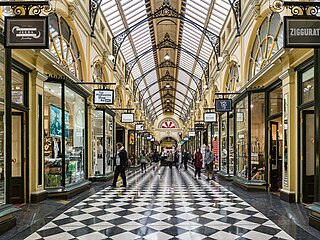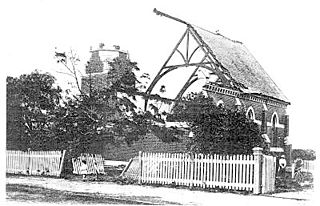
Docklands, also known as Melbourne Docklands, is an inner-city suburb in Melbourne, Victoria, Australia, 2 km (1.2 mi) west of Melbourne's Central Business District, located within the City of Melbourne local government area. Docklands recorded a population of 15,495 at the 2021 census.

The Royal Exhibition Building is a World Heritage-listed building in Melbourne, Victoria, Australia, built in 1879–1880 as part of the international exhibition movement, which presented over 50 exhibitions between 1851 and 1915 around the globe. The building sits on approximately 26 hectares, is 150 metres (490 ft) long and is surrounded by four city streets. It is at 9 Nicholson Street in the Carlton Gardens, flanked by Victoria, Carlton and Rathdowne Streets, at the north-eastern edge of the central business district. It was built to host the Melbourne International Exhibition in 1880–81, and then hosted the even larger Centennial International Exhibition in 1888, and the formal opening of the first Parliament of Australia in 1901. The building is representative of the money and pride Victoria had in the 1870s. Throughout the 20th century smaller sections and wings of the building were subject to demolition and fire; however, the main building, known as the Great Hall, survived.

Cremorne is an inner-city suburb in Melbourne, Victoria, Australia, 3 km (1.9 mi) south-east of the Melbourne central business district, located within the City of Yarra local government area. Cremorne recorded a population of 2,158 at the 2021 census.

Fitzroy is an inner-city suburb in Melbourne, Victoria, Australia, 3 km (1.9 mi) north-east of the Melbourne central business district, located within the City of Yarra local government area. Fitzroy recorded a population of 10,431 at the 2021 census.

Richmond is an inner-city suburb in Melbourne, Victoria, Australia, 3 km (1.9 mi) east of the Melbourne central business district, located within the City of Yarra local government area. Richmond recorded a population of 28,587 at the 2021 census, with a median age of 34.

Footscray is an inner-city suburb in Melbourne, Victoria, Australia, 5 km (3.1 mi) west of Melbourne's Central Business District, located within the City of Maribyrnong local government area and its council seat. Footscray recorded a population of 17,131 at the 2021 census.

The Skipping Girl Sign or Skipping Girl Vinegar Sign, colloquially known as Little Audrey is an historic animated neon sign in the inner suburb of Abbotsford, Melbourne, and was possibly the first animated neon sign in Australia when first erected in 1936. It advertised the Skipping Girl Vinegar brand, and was placed on top of the factory at 627 Victoria Street, Abbotsford. Removed in 1968, a reproduction was placed on a nearby factory at 651 Victoria Street in 1970 following a public outcry.

The Pelaco Sign is a heritage-listed neon sign located in the inner Melbourne suburb of Richmond. It was erected in 1939 as an advertisement for local shirt manufacturer Pelaco.
Esky is a brand of portable coolers, originally Australian, derived from the word "Eskimo". The term "esky" is also commonly used in Australia to generically refer to portable coolers or ice boxes and is part of the Australian vernacular, in place of words like "cooler" or "cooler box" and the New Zealand "chilly bin".

The Banana Alley Vaults are near the Flinders Street station in Melbourne, Australia and extend onto the North Bank of the Yarra River.

Borsari's Corner is at the intersection of Lygon and Grattan Streets, in Carlton, Victoria, Australia.
The Transport Ticketing Authority (TTA) was a statutory authority within the Department of Transport in the State Government of Victoria, Australia. It was established in June 2003 to manage Victoria's interest in the OneLink Metcard public transport ticketing system contract, and to procure and manage the new ticketing system for Victoria, eventually known as myki.

The Royal Arcade is a historic shopping arcade in the central business district of Melbourne, Victoria, Australia. Opened in 1870, it connects Bourke Street Mall to Little Collins Street, with a side offshoot to Elizabeth Street. It is the oldest surviving arcade in Australia, known for its elegant light-filled interior, and the large carved mythic figures of Gog and Magog flanking the southern entry.

Ivanhoe is a suburb of Melbourne, Victoria, Australia, 9 kilometres (5.6 mi) north-east of Melbourne's Central Business District, located within the City of Banyule local government area. Ivanhoe recorded a population of 13,374 at the 2021 census.

The Dingo Flour sign is a stylised silhouetted dingo in red on the side of a historic and heritage-listed working flour mill in North Fremantle, Western Australia.

Extreme weather events in Melbourne, Australia have occurred on multiple occasions. The city has experienced a number of highly unusual weather events and extremes of weather. An increase in heat waves and record breaking temperatures in the 21st century has led to much discussion over the effects of climate change in the country.

The Metro Tunnel is a metropolitan heavy rail project currently under construction in Melbourne, Victoria, Australia. It includes the construction of twin 9-kilometre (5.6 mi) rail tunnels between South Kensington and South Yarra with five new underground stations. The tunnel will connect the Pakenham and Cranbourne lines with the Sunbury line, creating a new high-frequency cross-city line that bypasses Flinders Street station and the City Loop. The line is also planned to serve Melbourne Airport via a new branch line west of Sunshine.
Andrew Robert Muirhead is an Australian former radio and television presenter for the Australian Broadcasting Corporation. He was the presenter of ABC Radio Hobart's breakfast program in Tasmania and also the presenter of the Collectors television program from 2005 to 2010. In 2012, he pleaded guilty to accessing child pornography and served four months of a five-month jail sentence.
Kamco is the company formed in 2003 to tender for a new public transport ticketing system in Victoria, Australia. It was contracted to provide the Myki ticketing system in 2005. It is a wholly owned subsidiary of the American company Keane, and when the myki contract was awarded it described itself as "an alliance" of Keane Australia, Ascom, ERG and Giesecke & Devrient, with Keane Australia providing "a single point of accountability" for Victoria's Transport Ticketing Authority. ERG was the creator of Metcard.
Nylex Plastics, founded in 1927, is an Australian manufacturer of a range of plastic goods. It was originally called the Australian Moulding Corporation but changed its name in 1948. The founder was John Derham. During the period between 1990 and 2009, the company was listed on the Australian Securities Exchange (ASX) and was considered to be the largest manufacturing company in Australia and in the top 25 largest companies in the country. It continues to operate in the form of its gardening products branch, which produces and sells plastic gardening products throughout Australia using the Nylex branding. A company that was previously a subsidiary, Nylex (Malaysia) Berhard, also still operates.
















